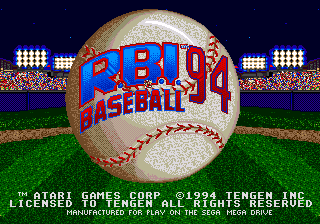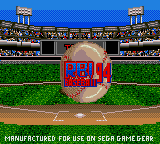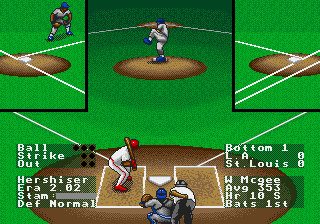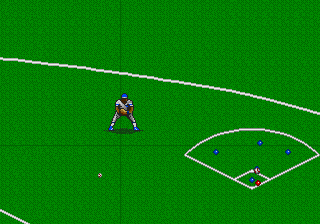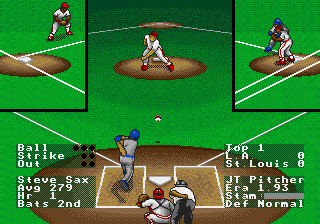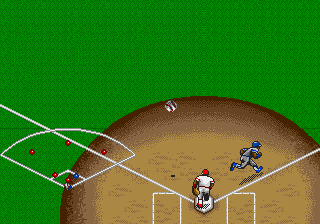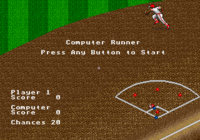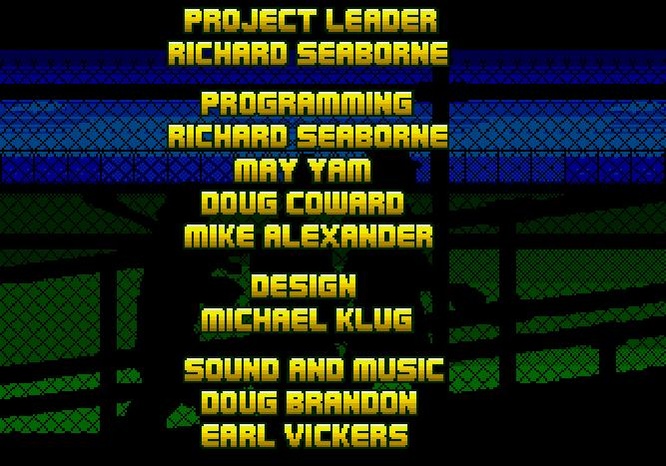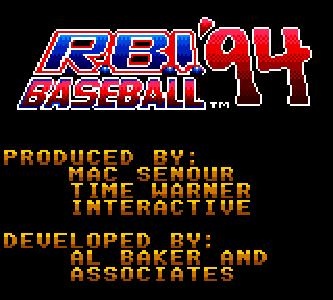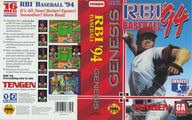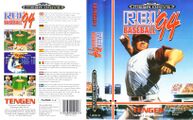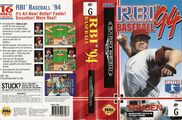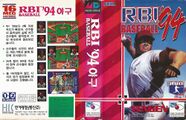R.B.I. Baseball '94
From Sega Retro
| R.B.I. Baseball '94 | |||||||||||||||||||||||||||||||||||
|---|---|---|---|---|---|---|---|---|---|---|---|---|---|---|---|---|---|---|---|---|---|---|---|---|---|---|---|---|---|---|---|---|---|---|---|
| System(s): Sega Mega Drive, Sega Game Gear | |||||||||||||||||||||||||||||||||||
| Publisher: Tengen Infocomm (KR) Time Warner Interactive | |||||||||||||||||||||||||||||||||||
| Developer: Tengen Al Baker & Associates | |||||||||||||||||||||||||||||||||||
| Supporting companies: Byte-Size Sound[1] (audio) | |||||||||||||||||||||||||||||||||||
| Distributor: Sega-Ozisoft (AU) HIC Infocomm (KR) | |||||||||||||||||||||||||||||||||||
| Licensor: Atari Games, Major League Baseball Players Association | |||||||||||||||||||||||||||||||||||
| Sound driver: GEMS | |||||||||||||||||||||||||||||||||||
| Peripherals supported: Gear-to-Gear Cable | |||||||||||||||||||||||||||||||||||
| Genre: Sports (baseball) | |||||||||||||||||||||||||||||||||||
| Number of players: 1-2 | |||||||||||||||||||||||||||||||||||
|
R.B.I. Baseball '94 is the sequel to R.B.I. Baseball '93. It was released for the Sega Mega Drive and Sega Game Gear. It is the final entry of the series for the Mega Drive and the only entry for the Game Gear.
In Europe, a run of cartridges was erroneously printed with the label upside down.
Contents
Gameplay
Mega Drive version
The game is a baseball game featuring the 26 teams and stadiums of the 1993 MLB season, including the two expansion teams that debuted in that season (the Colorado Rockies and the Florida Marlins, which now have full rosters). It has a Major League Baseball Players Association license, so it uses real player names, but it does not have a Major League Baseball license, so teams are identified only by locale and not by name. Gameplay is faster than the previous entries, the animation of pitchers, batters, and runners has been rotoscoped and uses more frames, players have baseball card-style portraits, the defense can change the positions of fielders or double switch during the game, pitchers have visible stamina gauges, the music has been redone, the play-by-play commentary has been redone by sportscaster Jack Buck, there are new full season modes, and there is a new "Pickles" mode (for practicing fielding and baserunning).
Modes
The game has the following modes:
- Play Ball: A nine-inning exhibition game between any two teams from either league (which can be the same team) or a series. The selectable series are Best of Seven (play any team in a best of seven playoff series), Play Division (play against every team in the 1993 American League, 1993 National League, American division winners, or National division winners), Play All Teams (play against every team in the game), 80 Game Season (a truncated season), or 162 Game Season (a full season). Series games use a password system for continuing.
- Home Run Derby: Players choose a team, a batter, and a pitch speed (60, 70, 80, 90, or 100). Each player gets 20 pitches and tries to hit as many home runs as possible. In two-player games, the stadium used belongs to player one's team. Awards are given for 3 (bronze), 5 (silver), 8 (gold), or 11 or more (grand prize) runs.
- Game Breakers: Players choose a team. Rather than starting a new game, players choose from a list of 17 situations, such as starting the eight inning down nine points, starting the ninth inning with neither team having any points, or being in the bottom of the eighth inning ahead one point but with the opposing team having bases loaded and no outs. After choosing a situation, players choose a relief pitcher and finish the game with the selected premise. A password is given after each completed game.
- Create Teams: Players can create custom teams with any players, which can be used in any of the other modes.
- Stadium Tour: An overhead view of any of the 30 ballparks in the game (one for every team, plus an American League and a National League stadium).
- View Roster: View all of the team rosters and statistics for any player.
- Defense Practice: Practice playing defense in 20 different infield and outfield defensive situations. A computer-controlled batter hits a ball off a tee, and the player controls the fielders.
- Pickles: Practice fielding and baserunning in "pickles," situations where a baserunner is between two bases. Player one controls a fielder and must catch the ball and try to tag out the runner, while player two controls the baserunner and must try to make it safely to base. After 10 situations, the sides switch for another 10 situations.
- View Portraits: View the portraits for every player in the game.
Games can be played as Human vs. Comp (single-player, where the player is the visiting team and bats first), Comp vs. Human (single-player, where the player is the home team and bats last), Human vs. Human (two-player game, where player two as the home team), or Comp vs. Comp (two computer-controlled teams play each other, which can be overridden by either control pad to take over play or make substitutions). Before each game, players choose any team and set the batting line-up and choose starting and relief pitchers. A pitcher can only start every other game in a series.
In the options, players can choose from three difficulty levels for computer-controlled opponents (Easy, Medium, and Hard), set the defense mode (computer-assisted for partial assistance or fully automated or manual fielding), toggle errors (whether fielders occasionally make errors such as dropping the ball), or toggle "crazyball" ("crazy" sound effects replace the normal ones).
Teams
Current
The game includes all 28 teams from the 1993 MLB season, with their stadiums. Teams are divided into three divisions, though this would not happen until the next season in real life.
| League | Division | Team | Based on |
|---|---|---|---|
| American | West | California | California Angels |
| Oakland | Oakland Athletics | ||
| Seattle | Seattle Mariners | ||
| Texas | Texas Rangers | ||
| Central | Chicago | Chicago White Sox | |
| Cleveland | Cleveland Indians | ||
| Kansas City | Kansas City Royals | ||
| Milwaukee | Milwaukee Brewers | ||
| Minnesota | Minnesota Twins | ||
| East | Baltimore | Baltimore Orioles | |
| Boston | Boston Red Sox | ||
| Detroit | Detroit Tigers | ||
| New York | New York Yankees | ||
| Toronto | Toronto Blue Jays | ||
| National | West | Colorado | Colorado Rockies |
| Los Angeles | Los Angeles Dodgers | ||
| San Diego | San Diego Padres | ||
| San Francisco | San Francisco Giants | ||
| Central | Pittsburgh | Pittsburgh Pirates | |
| Chicago | Chicago Cubs | ||
| Cincinnati | Cincinnati Reds | ||
| Houston | Houston Astros | ||
| St. Louis | St. Louis Cardinals | ||
| East | Florida | Florida Marlins | |
| Montreal | Montreal Expos | ||
| New York | New York Mets | ||
| Philadelphia | Philadelphia Phillies | ||
| Atlanta | Atlanta Braves |
Previous
In addition, the game includes historical rosters of every division-winning team going back to 1985 (following the previous two-division structure).
| League | Year | West | East | ||
|---|---|---|---|---|---|
| Team | Based on | Team | Based on | ||
| American | 1993 | Chicago | Chicago White Sox | Toronto | Toronto Blue Jays |
| 1992 | Oakland | Oakland Athletics | Toronto | Toronto Blue Jays | |
| 1991 | Minnesota | Minnesota Twins | Toronto | Toronto Blue Jays | |
| 1990 | Oakland | Oakland Athletics | Boston | Boston Red Sox | |
| 1989 | Oakland | Oakland Athletics | Toronto | Toronto Blue Jays | |
| 1988 | Oakland | Oakland Athletics | Boston | Boston Red Sox | |
| 1987 | Minnesota | Minnesota Twins | Detroit | Detroit Tigers | |
| 1986 | California | California Angels | Boston | Boston Red Sox | |
| 1985 | Kansas City | Kansas City Royals | Toronto | Toronto Blue Jays | |
| National | 1993 | Atlanta | Atlanta Braves | Philadelphia | Philadelphia Phillies |
| 1992 | Atlanta | Atlanta Braves | Pittsburgh | Pittsburgh Pirates | |
| 1991 | Atlanta | Atlanta Braves | Pittsburgh | Pittsburgh Pirates | |
| 1990 | Cincinnati | Cincinnati Reds | Pittsburgh | Pittsburgh Pirates | |
| 1989 | San Francisco | San Francisco Giants | Chicago | Chicago Cubs | |
| 1988 | Los Angeles | Los Angeles Dodgers | New York | New York Mets | |
| 1987 | San Francisco | San Francisco Giants | St. Louis | St. Louis Cardinals | |
| 1986 | Houston | Houston Astros | New York | New York Mets | |
| 1985 | Los Angeles | Los Angeles Dodgers | St. Louis | St. Louis Cardinals | |
All-Star
Finally, the game includes All-Star teams for each league going back to 1989.
| League | Team |
|---|---|
| American | 1993 American League All-Stars |
| 1992 American League All-Stars | |
| 1991 American League All-Stars | |
| 1990 American League All-Stars | |
| 1989 American League All-Stars | |
| National | 1993 National League All-Stars |
| 1992 National League All-Stars | |
| 1991 National League All-Stars | |
| 1990 National League All-Stars | |
| 1989 National League All-Stars |
Production credits
Mega Drive version
- Project Leader: Richard Seaborne
- Programming: Richard Seaborne, May Yam, Doug Coward, Michael Alexander
- Design: Michael Klug
- Sound and Music: Doug Brandon, Earl Vickers
- Graphics and Animation: Fred Andrews, Jose Erazo, Doug Gray, Manuel Laguatan, Jules Marino
- Special Thanks: John Arvay, Bill Hindorff, Rob Boone, Dave Portera, Steve Calfee, Rob Rowe
Game Gear version
- Produced by: Mac Senour, Time Warner Interactive
- Developed by: Al Baker and Associates
- Design and Direction: Tom Fessler
- Programmed by: Al Baker
- Music and SFX: Matt Scott
- Artwork: Tom Fessler, Rick Incrocci, Dave Pascuito
- Testing: Tom Christiansen, Nathan Baker, Raoul Faulkner
Magazine articles
- Main article: R.B.I. Baseball '94/Magazine articles.
Promotional material
also published in:Expand
also published in:Expand
Physical scans
Mega Drive version
| ExpandSega Retro Average |
|---|
| 74 | |
|---|---|
| Based on 25 reviews | |
Game Gear version
| ExpandSega Retro Average |
|---|
| 67 | |
|---|---|
| Based on 2 reviews | |
Technical information
- Main article: R.B.I. Baseball '94/Technical information.
References
- ↑ https://bytesizesound.com/productcredits.html (Wayback Machine: 2023-12-06 18:00)
- ↑ Jump up to: 2.0 2.1 GamePro, "April 1994" (US; 1994-xx-xx), page 129
- ↑ Jump up to: 3.0 3.1 3.2 Game Players, "Vol. 7 No. 4 April 1994" (US; 1994-0x-xx), page 80
- ↑ Jump up to: 4.0 4.1 4.2 4.3 Mean Machines Sega, "June 1994" (UK; 1994-04-30), page 68
- ↑ Computer Trade Weekly, "" (UK; 1994-06-06), page 17
- ↑ Electronic Gaming Monthly, "October 1994" (US; 1994-xx-xx), page 164
- ↑ File:R.B.I. Baseball '94 MD credits.pdf
- ↑ File:R.B.I. Baseball '94 GG credits.pdf
- ↑ VideoGames, "July 1994" (US; 1994-0x-xx), page 95
- ↑ Electronic Gaming Monthly, "May 1994" (US; 1994-xx-xx), page 8
- ↑ Electronic Gaming Monthly, "June 1994" (US; 1994-xx-xx), page 84
- ↑ 1700 igr dlya Sega, "" (RU; 2001-xx-xx), page 185
- ↑ Consoles +, "Juin 1994" (FR; 1994-0x-xx), page 130
- ↑ Computer & Video Games, "July 1994" (UK; 1994-06-15), page 98
- ↑ Electronic Games (1992-1995), "July 1994" (US; 1994-0x-xx), page 75
- ↑ Electronic Gaming Monthly, "June 1994" (US; 1994-xx-xx), page 38
- ↑ GamePro, "May 1994" (US; 1994-xx-xx), page 109
- ↑ GamesMaster, "July 1994" (UK; 1994-06-30), page 66
- ↑ Games World: The Magazine, "July 1994" (UK; 1994-05-26), page 16
- ↑ Game Informer, "May/June 1994" (US; 1994-0x-xx), page 42
- ↑ MAN!AC, "07/94" (DE; 1994-06-08), page 71
- ↑ Mega, "July 1994" (UK; 1994-06-16), page 37
- ↑ Mega Fun, "07/94" (DE; 1994-06-22), page 53
- ↑ MegaTech, "July 1994" (UK; 1994-06-16), page 50
- ↑ Play Time, "7/94" (DE; 1994-06-08), page 136
- ↑ Sega Magazin, "Juni 1994" (DE; 1994-05-11), page 68
- ↑ Sega Magazine, "June 1994" (UK; 1994-05-15), page 86
- ↑ Sega Power, "July 1994" (UK; 1994-05-05), page 56
- ↑ Sega Pro, "June 1994" (UK; 1994-05-24), page 58
- ↑ Sega Force, "6/94" (SE; 1994-09-14), page 16
- ↑ Sonic the Comic, "August 19th 1994" (UK; 1994-08-06), page 10
- ↑ Todo Sega, "Agosto 1994" (ES; 1994-0x-xx), page 38
- ↑ Tricks 16 bit, "Tricks Sega Gold 800 igr" (RU; 1998-03-20), page 207
- ↑ Video Games, "8/94" (DE; 1994-07-27), page 90
- ↑ Game Players, "Vol. 7 No. 12 December 1994" (US; 1994-1x-xx), page 178
- ↑ Game Informer, "January 1995" (US; 199x-xx-xx), page 44
| CollapseR.B.I. Baseball '94 | |
|---|---|
|
Main page | Comparisons | Hidden content | Magazine articles | Reception | Region coding | Technical information | |
| CollapseR.B.I. Baseball games for Sega systems | |
|---|---|
| R.B.I. Baseball 3 (1991) | R.B.I. Baseball 4 (1992) | R.B.I. Baseball '93 (1993) | R.B.I. Baseball '94 (1994) | R.B.I. Baseball '95 (unreleased) | RBI Baseball '95 (1995) | |
- Gear-to-Gear Cable-compatible games
- 1-2 player games
- US Mega Drive games
- All US games
- EU Mega Drive games
- All EU games
- UK Mega Drive games
- All UK games
- AU Mega Drive games
- All AU games
- KR Mega Drive games
- All KR games
- Mega Drive games
- 1994 Mega Drive games
- All 1994 games
- Mega Drive baseball games
- Mega Drive sports games
- All sports games
- US Game Gear games
- Game Gear games
- 1994 Game Gear games
- Game Gear baseball games
- Game Gear sports games
- All games
- R.B.I. Baseball '94
- R.B.I. Baseball

